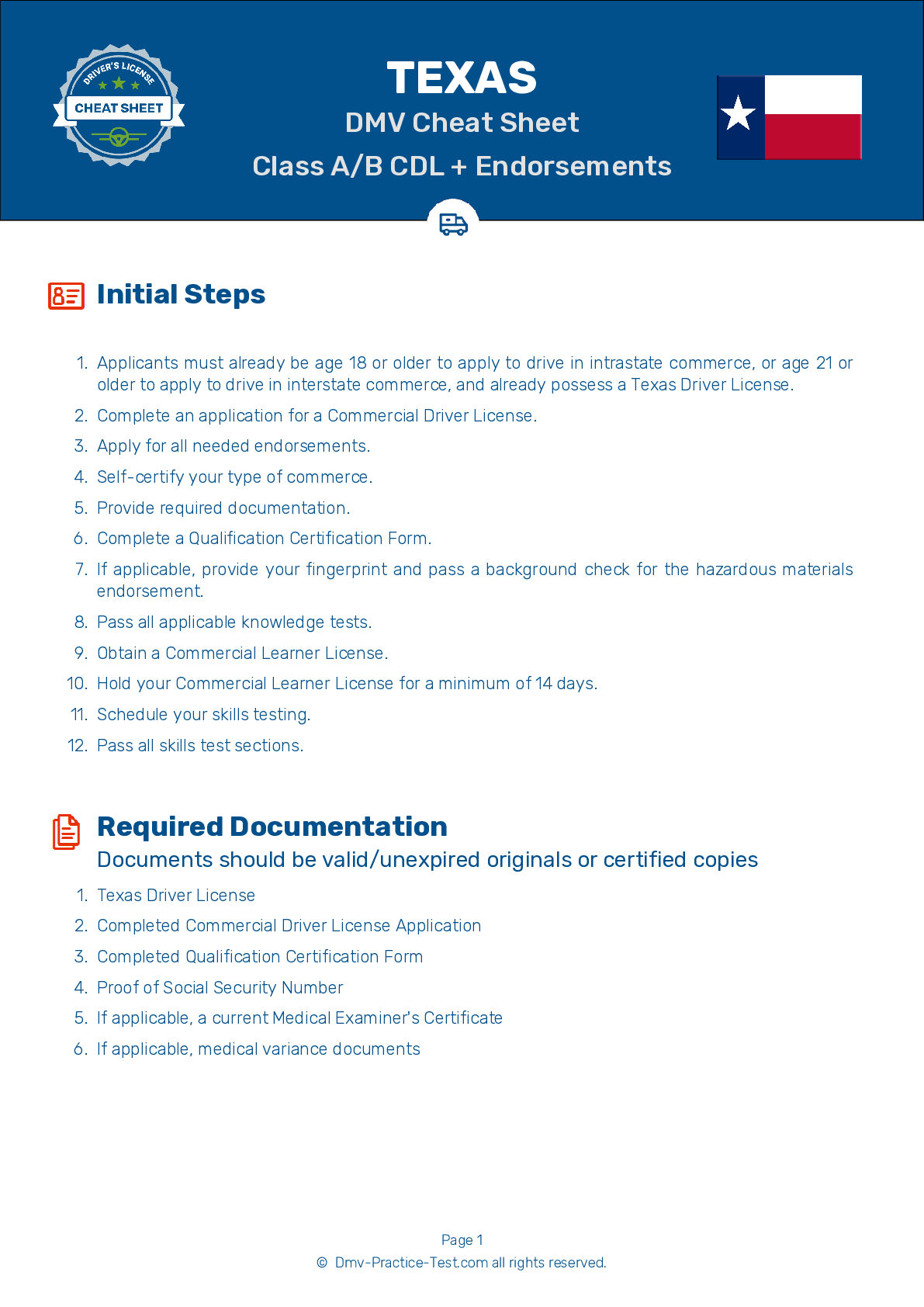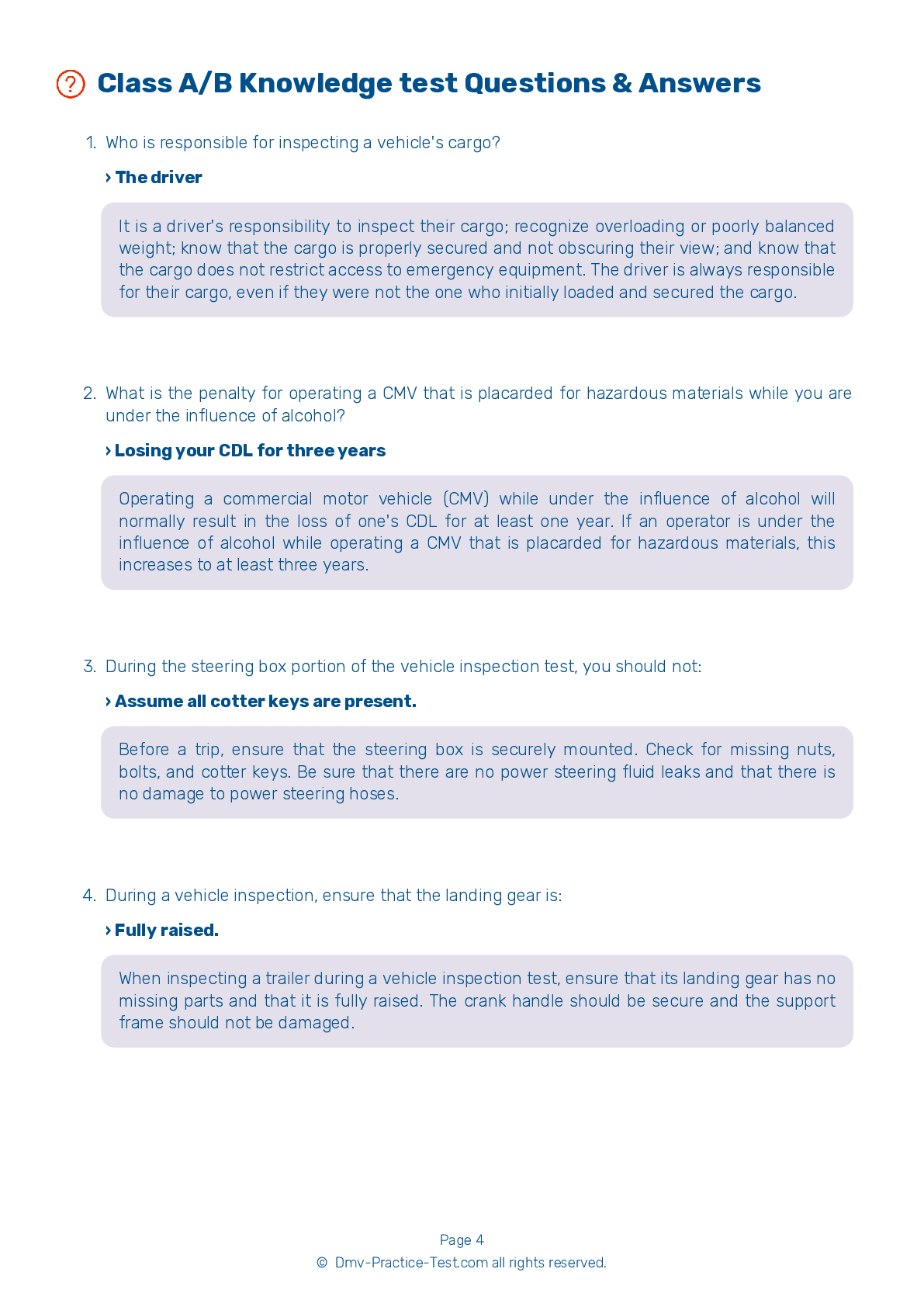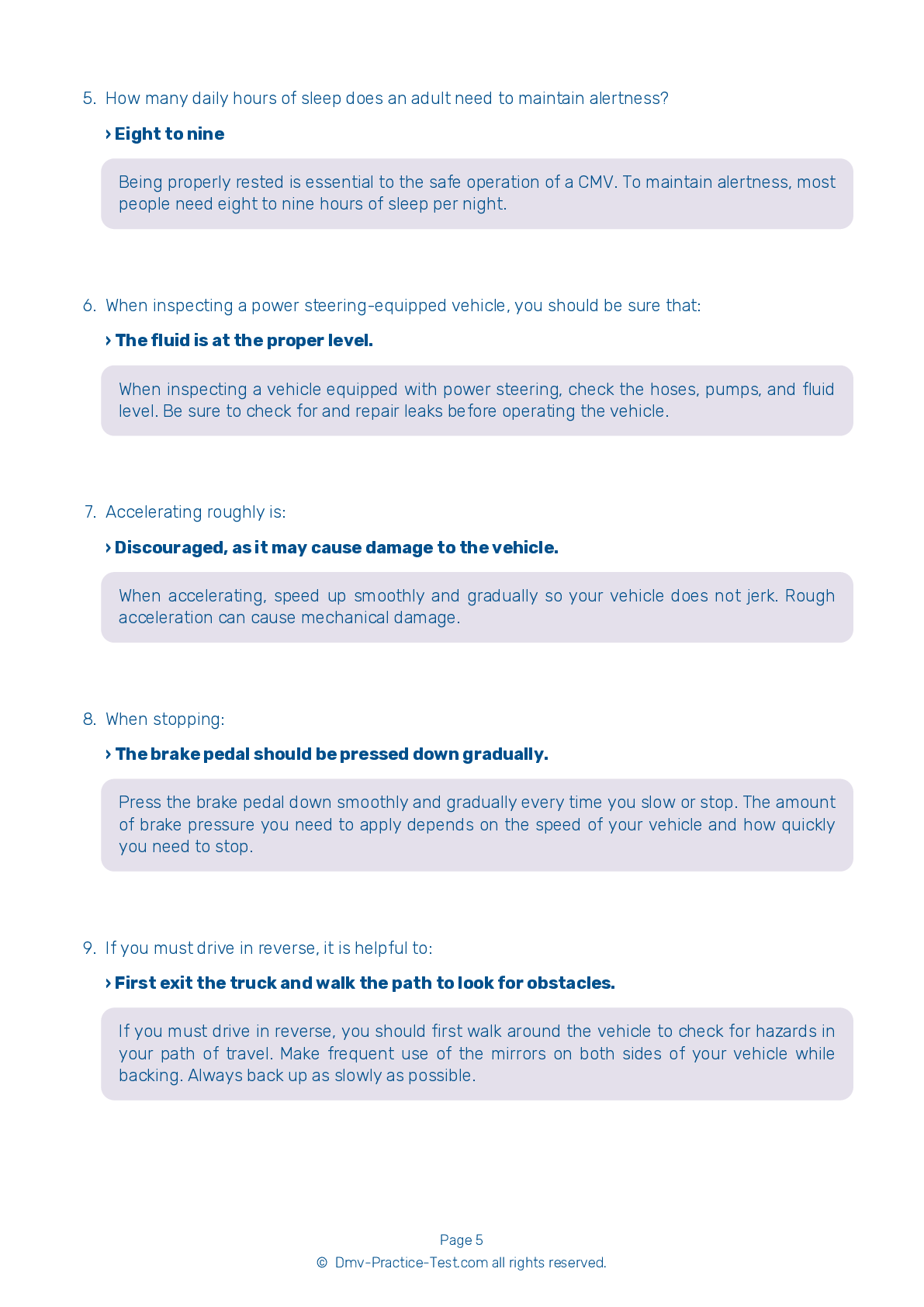Knowledge Test Class A #1
Class A Driving Test | Texas 2025 #1 Page 10 of 10
Train for FREE online with our Texas class A license test. The official exam test consists of several obligatory parts, with all of them checking your knowledge of different blocks of road rules. If you need to obtain a TX CDL class A permit in 2025, practice as much as possible. Free sample tests published on our website will help you check and improve your knowledge and boost your grades. Please bear in mind that CDL class A requirements may vary from state to state.
70
56
22
64 . What is the penalty for operating a CMV that is placarded for hazardous materials while you are under the influence of alcohol?
Losing your CDL for three years
Operating a commercial motor vehicle (CMV) while under the influence of alcohol will normally result in the loss of one's CDL for at least one year. If an operator is under the influence of alcohol while operating a CMV that is placarded for hazardous materials, this increases to at least three years.
65 . When operating a vehicle with a dual brake system, a driver should:
Pump the pedal about 20 times to build pressure, then begin driving.
Before driving a vehicle with a dual air system, allow time for the air compressor to build up a minimum pressure of 100 psi in both the primary and secondary systems.
66 . When checking tire condition during the vehicle inspection, you should:
Ensure that the tires have even wear.
When examining your tires during the vehicle inspection test, you should ensure that treads are evenly worn.
67 . When checking the power steering fluid during a vehicle inspection, you will need to do each of the following, except:
Ensure that the power steering level is above the refill mark.
When checking the power steering fluid during the vehicle inspection test, you must be able to indicate where the power steering fluid dipstick is located and show that there is an adequate amount of power steering fluid in the engine compartment. The fluid level must be above the refill mark.
68 . Placards should be used:
If the hazardous materials create an inhalation hazard.
Placards must be placed on the outside of vehicles carrying hazardous materials. They identify the specific class or classes of materials being carried and warn others of relevant hazards.
69 . During a vehicle inspection, ensure that lug nuts are all of the following, except:
Free of rust.
During a vehicle inspection test, you must ensure that all lug nuts are present, free of cracks and distortions, and showing no signs of looseness, such as rust trails or shiny threads. Verify that all bolt holes are free of cracks and distortions.
70 . A tread depth of ____ should be in every major groove of a tire that is not in the front of a commercial motor vehicle.
4/32 of an inch
For safe operation, a commercial motor vehicle needs a tread depth of 4/32 of an inch in every major groove on the front tires, and a tread depth of 2/32 of an inch on other tires.
2025 Texas | Frequently Asked Questions
A CDL Class A license in Texas permits drivers to operate any combination of vehicles with a Gross Combination Weight Rating (GCWR) of 26,001 pounds or more, provided the Gross Vehicle Weight Rating (GVWR) of the vehicle(s) being towed is over 10,000 pounds. It covers vehicles like tractor-trailers, truck and trailer combinations, and tank vehicles.
A Class A CDL license in Texas allows the holder to operate vehicles such as tractor-trailers, truck and trailer combinations, tank vehicles, livestock carriers, and flatbeds. These are typically vehicles with a Gross Combination Weight Rating (GCWR) of 26,001 pounds or more where the towed vehicle exceeds 10,000 pounds.
To obtain a Class A CDL license in Texas, you must be at least 18 years old (21 for interstate driving), possess a valid Texas driver's license, pass a vision exam, and successfully complete both a written knowledge test and a three-part skills test. Additionally, you must provide proof of citizenship or lawful presence and pass a medical examination.
In Texas, you must be at least 18 years old to qualify for a Class A CDL license for intrastate driving (within Texas only). However, to drive a commercial vehicle across state lines (interstate), federal regulations require drivers to be at least 21 years old.
Specific endorsements are not required for a Class A CDL license, but they can provide additional driving privileges. Endorsements include T for double/triple trailers, P for passenger vehicles, N for tank vehicles, H for hazardous materials, and S for school buses. Each endorsement requires passing additional written and/or skills tests.
The Class A CDL skills test in Texas includes three parts: a pre-trip vehicle inspection, a basic vehicle control test, and an on-road driving test. These are designed to assess your ability to safely operate and maintain a Class A commercial vehicle. The test must be taken in a vehicle representative of the one you'll be driving.
Yes, there can be limitations for Class A CDL license holders. These are called restrictions and are marked on the license. For example, if you cannot operate a manual transmission, you may have an automatic only restriction. If you don't pass the air brakes test, your license will show you're not permitted to drive vehicles with air brakes.
Yes, it is possible to take the written Class A CDL test in languages other than English in Texas. However, the Department of Public Safety recommends that applicants have a basic understanding of English due to the English Language Proficiency requirement, which mandates drivers understand traffic signs and signals in English.
Yes, you can request accommodations for the Class A CDL written test if you have a disability. Texas Department of Public Safety provides reasonable testing accommodations according to the Americans with Disabilities Act. However, you must provide adequate documentation of your disability and you may need to make the request in advance.
Yes, if you don't pass the Class A CDL written test in Texas, you can retake it. However, you must wait at least one day before retesting. If you fail the test three times, you are required to wait 30 days before retesting. After failing six times, you must wait 90 days. Each retake does require an additional fee.



